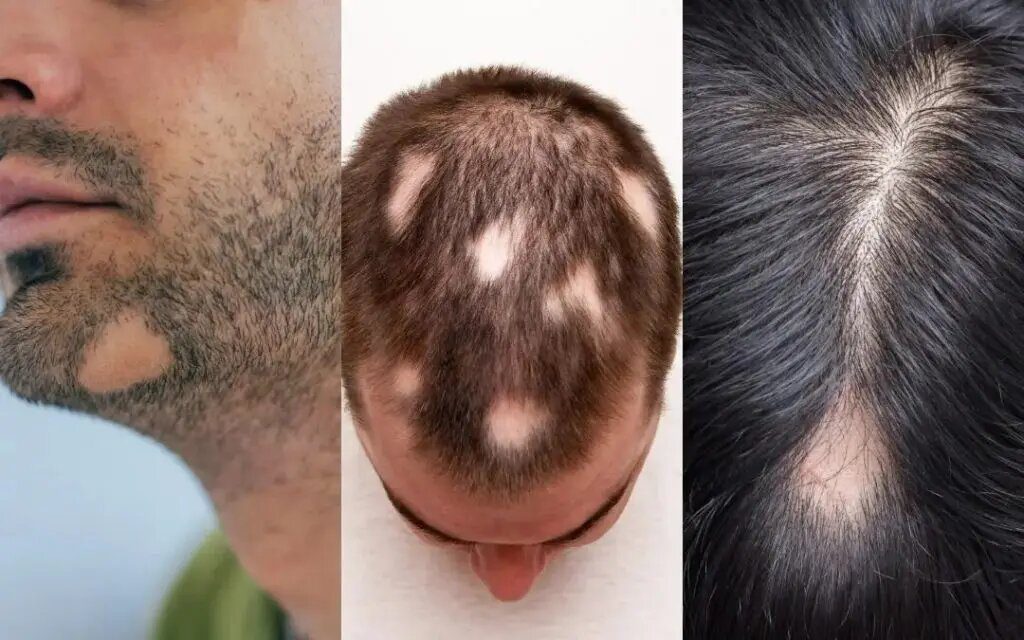
alopecia areata
Contents:
Overview of alopecia areata
Alopecia areata is a disease that occurs when the immune system attacks the hair follicles and causes hair loss. Hair follicles are structures in the skin that form hair. While hair can fall out on any part of the body, alopecia areata usually affects the head and face. The hair usually falls out in small, quarter-sized round patches, but in some cases, the hair loss is more extensive. Most people with this condition are healthy and have no other symptoms.
The course of alopecia areata varies from person to person. Some people have bouts of hair loss throughout their lives, while others have only one episode. Recovery is also unpredictable, with some people growing their hair back completely and others not.
There is no cure for alopecia areata, but there are methods that help hair grow back faster. There are also resources to help people deal with hair loss.
Who gets alopecia areata?
Everyone can have alopecia areata. Men and women receive it equally, and it affects all racial and ethnic groups. The onset can be at any age, but for most people it occurs in their teens, twenties, or thirties. When it occurs in children under the age of 10, it tends to be more extensive and progressive.
If you have a close family member with the condition, you may be at a higher risk of contracting it, but many people do not have a family history. Scientists have linked a number of genes to the disease, suggesting that genetics play a role in alopecia areata. Many of the genes they discovered are important for the functioning of the immune system.
People with certain autoimmune conditions, such as psoriasis, thyroid disease, or vitiligo, are more prone to alopecia areata, as are people with allergic conditions, such as hay fever.
It is possible that alopecia areata can be caused by emotional stress or illness in people at risk, but in most cases there are no clear triggers.
Types of alopecia areata
There are three main types of alopecia areata:
- Focal focal alopecia. In this type, which is the most common, hair loss occurs as one or more coin-sized patches on the scalp or other parts of the body.
- total alopecia. People with this type lose all or almost all hair on their heads.
- Universal alopecia. In this type, which is rare, there is a complete or near total loss of hair on the head, face, and the rest of the body.
Symptoms of alopecia areata
Alopecia areata primarily affects the hair, but in some cases changes to the nails are also possible. People with this disease are usually healthy and have no other symptoms.
Hair Changes
Alopecia areata usually begins with a sudden loss of round or oval patches of hair on the head, but any part of the body can be affected, such as the beard area in men, eyebrows or eyelashes. The margins of the patch often have short broken or exclamation mark hairs that are narrower at the base than at the tip. Usually, the exposed areas show no signs of rash, redness, or scarring. Some people report that they feel tingling, burning or itching in areas of the skin right before hair loss.
Once a bare spot develops, it is difficult to predict what will happen next. Features include:
- Hair grows back within a few months. It may appear white or gray at first, but over time it may return to its natural color.
- Additional open areas develop. Sometimes the hair grows back in the first section while new bare patches form.
- Small spots merge into larger ones. In rare cases, the hair eventually falls out over the entire scalp, which is called total alopecia.
- There is a progression to complete loss of body hair, a type of condition called alopecia universalis. It is a rarity.
In most cases, the hair grows back, but there may be subsequent episodes of hair loss.
Hair tends to grow back on its own more completely in people with:
- Less extensive hair loss.
- Later age of onset.
- No nail changes.
- No family history of disease.
Nail changes
Nail changes such as ridges and pits occur in some people, especially those with more severe hair loss.
Causes of alopecia areata
In alopecia areata, the immune system mistakenly attacks the hair follicles, causing inflammation. Researchers don't fully understand what triggers an immune attack on hair follicles, but they believe both genetic and environmental (non-genetic) factors play a role.
Leave a Reply